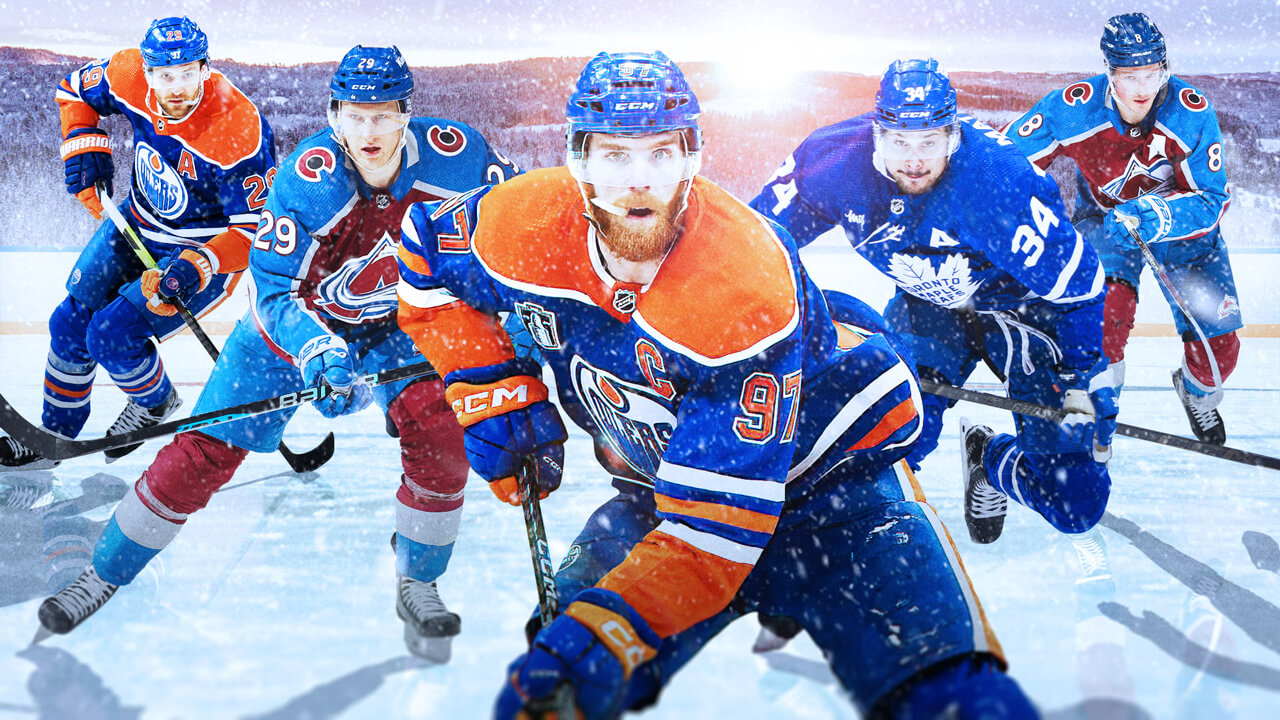
THE NHL’S TOP 50 PLAYERS: 10-1
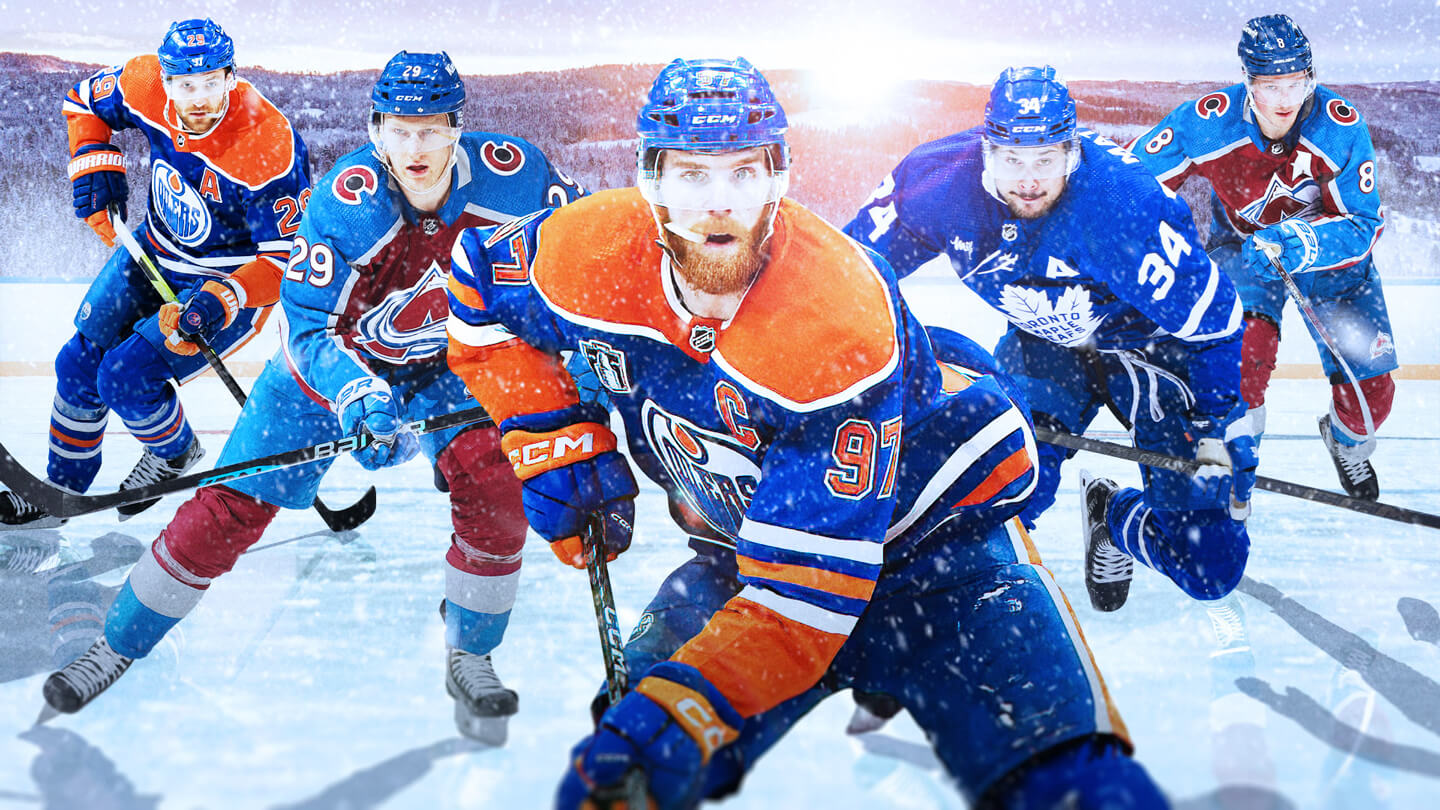
H
alf a decade into a long-awaited offensive renaissance, the National Hockey League has entered something of a golden era.
Take a brief glimpse at what’s playing out under the lights on a nightly basis and it’s plain to see: the game is brimming with limitless skill, with dizzying speed. In the face of that swell of talent, creativity, and jaw-dropping production, we’ve asked the question: If today’s game is truly pushing the sport to new ground, who is leading the charge? Who are the kings of this golden age?
We turned to our Sportsnet Insiders for an answer, asking them to untangle the whirlwind of sticks, skates, and bodies flying around the sheet, and rank the top 50 players in the NHL at this moment. Not just the best forwards or defenders, not just the best offensive-minded phenoms or shutdown talents, but the best — full-stop.
Fifty names, one list. Who comes out on top?
There was only one ground rule: This ranking is forward-looking. It doesn’t factor in legacy or stature in the game — it considers only how the league’s best are expected to perform in 2024-25. The overall ranking below is an amalgam of the Top 50 lists from Insiders across the network. For each Insider’s list, players were assigned points based on how high they finished in that particular ranking — the higher they ranked on an Insider’s list, the more points they accrued. Each player’s position on the overall ranking is a result of how many total points they collected across all of the Insiders’ lists.
With that, here is Sportsnet’s ranking of the Top 50 Players in the NHL, concluding with the best of the best — Nos. 10-1.

What makes Mikko Rantanen so indomitable, so uncontainable, is the sheer breadth of his skillset. It’s not just that he can walk in, square up, and wire pucks past the league’s best like it’s nothing. It’s not only that he can just as easily play facilitator to one of the all-world teammates buzzing around him. It’s not just the size and strength, the six-foot-four, 215-pound frame that makes him a chore to push off the puck. Nor is it the way he makes up for a lack of top-end speed with a deceptive grace that lets him fly right by the opposition all the same. It’s all of it, all together, the versatility that’s turned him into the stuff of defender’s nightmares. Throw him on the left wing, or the right, or down the middle — regardless, Rantanen’s proven able to get to his game and inflict his offensive will . And yet, plying his trade in the shadow of two superstars in Colorado, you could argue he’s flown under the radar relative to what he’s done in this league.
Since he debuted in Denver, the 27-year-old has grown into one of the most prolific scoring threats on the wing league-wide — over the course of his nine years in the big leagues, Rantanen’s amassed the seventh-most points of any winger in the game. He’s upped the ante even more of late, growing into peak form over the past two seasons with a pair of 100-point campaigns and 97 goals over that span, too. In that two-year stretch, only two wingers in the league have managed to outscore Rantanen, and only one’s managed to rack up more goals than the Colorado stalwart. Now, entering the final year of his contract, all eyes will be on whether the Avs and the veteran Finn can agree on a deal that keeps him in Denver long-term.


In one sense, it’s no surprise Sidney Crosby remains among the game’s best, even after all these years. In another, it is a signature achievement, one more in an absurdly long line of them, that the Pittsburgh Penguins captain has managed to stay at this level for this long. No. 87 has made a habit of authoring resurgent campaigns just when the hockey world begins to write him off. It’s what he did when injuries threatened to derail him early in his big-league tenure, Crosby eventually returning with a century season that earned him his second Art Ross. It’s what he did in the half-decade after that, when his Penguins era seemed to have run its course, the captain turning trade chatter into back-to-back Stanley Cups, and back-to-back Conn Smythe trophies. And over the past two campaigns, it’s what Crosby’s done again, putting up a pair of 90-point seasons — and the third-best goal-scoring effort of his career — as he approaches his 40s.
Beyond the details of Crosby’s game — the way he excels, like no one else in the sport, at the second-by-second minutiae of wreaking offensive havoc — it’s his adaptability that makes No. 87 an all-time figure in the hockey world. That’s been the case from the very beginning, as he came back season after season with some skill tweaked, some ability enhanced. Here, in the twilight of his career, he’s still doing it, altering his game to keep up with a league that seems to be running a hundred miles-per-hour faster than it did when he was in his prime. Whether that’s enough to pull the team around him back into playoff relevancy remains unclear. But coming off another summer of roster tweaks, with a new young linemate to mold into an ideal wingman, it would be foolish to count Crosby out.

Looking back now, Quinn Hughes’s very first NHL point, in his very first game, might’ve told us all we needed to know about what he would eventually become in this league. Rewind to that 2018-19 campaign and there’s Hughes, taking the ice for that first spin with all eyes on his much-anticipated debut, the weight of the Canucks faithful’s expectations on his shoulders. It took just 35 minutes as an NHLer for him to put the league on notice — for him to corral the puck and cut down the wing, to swerve behind the net and bank it off the back of the cage to himself, before wheeling back in front to try beating a two-time Cup champion netminder. It was more than the move itself that announced his arrival, the skill required to carry out any part of that sequence. It was the gall to even try it — the confidence to know he could bob and weave and think his way out of trouble. Half a decade later, the league has yet to find a way to stymie him.
Hughes’s debut season made clear he could be one of the game’s premier offensive blue-liners. The next few years confirmed it. But the 2023-24 campaign pushed the 24-year-old into a different stratosphere, a 92-point outburst positioning him not only among the league’s best rearguards, but among the best offensive practitioners full-stop. Captaining a Canucks team quickly becoming a force in the West, it’s become a fool’s errand trying to predict just how high Hughes can push his ceiling. He’s done everything Vancouver has asked of him to this point. The next step: Bringing that dominance into the post-season and pulling the Canucks closer to banner-hanging territory.


David Pastrnak seemed destined for greatness from the jump, making his presence known with a 35-goal campaign just three years into his NHL career. Halfway through his decade in Boston, he was already proving one of the most productive wingers in the game, a lock for 35 goals and 80 points, his trajectory appearing to arc sky-high — all this while dazzling the Bruins faithful with whirling displays of stickhandling wizardry each night. At 23, he took it one step further, winning the Rocket Richard with a 48-goal, 95-point outburst, and earning the first Hart Trophy votes of his career, too. Just a few years after that, he was sniping 60 — joining one of the most exclusive goal-scoring clubs in the modern NHL — while topping 100 points for the first time and collecting his first Hart nomination. No, for Pastrnak, it was never a question of how high he might reach — it was simply whether his success was a product of his environment or whether that environment was a product of him.
Last season, Pastrnak gave us the answer. Returning to Boston for 2023-24 with the club’s centre depth decimated — longtime leaders Patrice Bergeron and David Krejci retiring from the game — Pastrnak simply picked up where he left off, unfazed. The 27-year-old put up 110 points on the year — his second-straight season reaching that plateau — finishing as the fifth-highest scorer in the game, the third-highest-scoring winger. The message was clear: Put anyone you want beside the Bruins talisman, and he’s going to do what he does. Pastrnak is the engine pushing the B’s offence forward. That said, in 2024-25, he’ll have elite help once again, the club’s move to bring in Elias Lindholm giving him a chance to take yet another step next time out.

If there was confusion about who currently reigns as the greatest winger in the game, the five-year run that Nikita Kucherov’s stitched together has cemented the answer. The Tampa Bay Lightning’s resident MVP candidate is a different animal from the rest of the league’s top scorers. The highlight reel doesn’t quite pop like it does for the other names surrounding him on this list. But there is one consistent element in a Kucherov highlight: acres of open white ice around No. 86, earned not from the opposition’s lack of focus but from the fine-tuning of Kucherov’s own. The 31-year-old’s stature as one of the sport’s most prolific talents wasn’t earned only through physical gifts — it was born of Kucherov out-thinking his opponents at every turn, anticipating their every move. Putting passes on a tee for teammates who haven’t even arrived yet. Spying gaps on the sheet before they open up.
And for the past half-decade, that’s turned Kucherov into a force to be reckoned with. Since his sterling 2018-19 campaign — a 128-point breakout that netted him an Art Ross Trophy, a Hart Trophy, and a Ted Lindsay Award — Kucherov’s gone on to claim back-to-back Stanley Cups (leading the playoffs in scoring during both runs), two more 100-point campaigns, and another scoring title last season for a ridiculous 144-point effort. His game might not be quite as well-rounded, quite as dynamic or explosive, as the other all-world scorers on this list. But the veteran winger has managed to dominate regardless, and fresh off a career year at age 30, seems to only be getting more lethal.
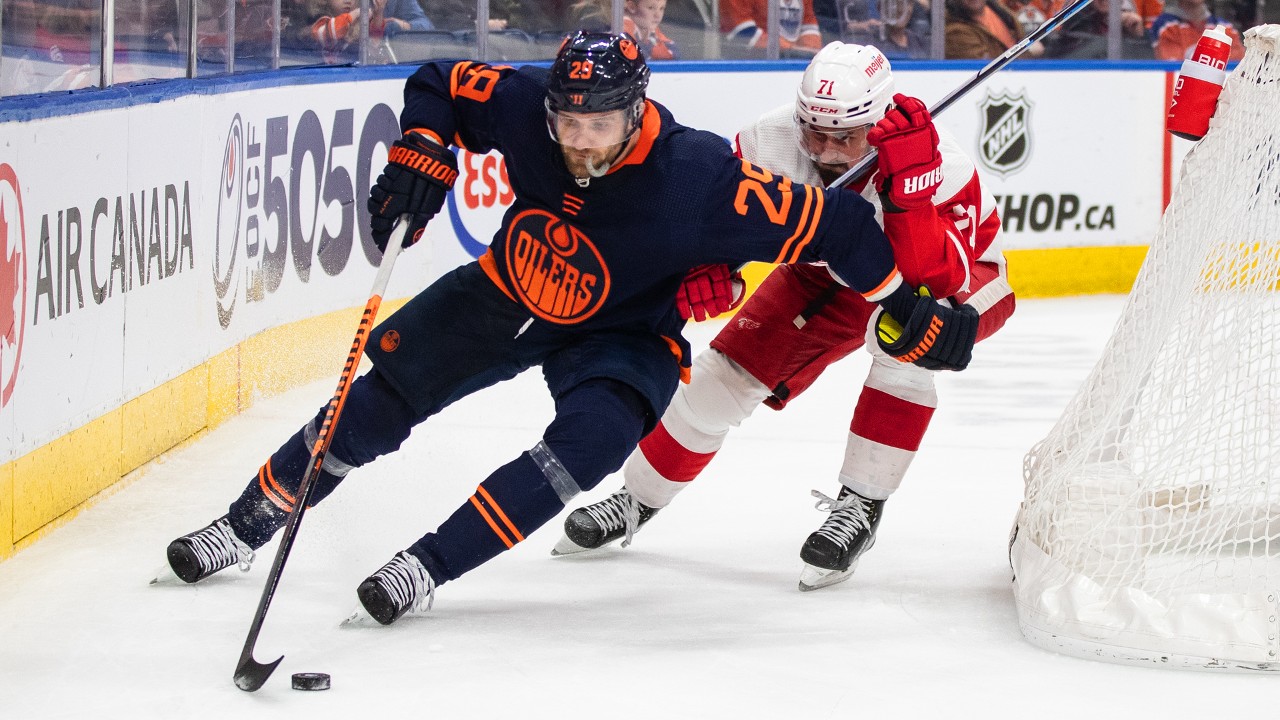

There’s no separating Leon Draisaitl from the generational phenomenon he plays alongside in Edmonton. But to dismiss all that the German pivot has done in the game simply because he shares a roster with Connor McDavid would be as silly as suggesting the success he’s found hasn’t been influenced by No. 97 at all. In truth, it’s the magic of their symbiosis that has allowed the Oilers to thrive, a partnership that has gelled into something near-unstoppable, launching both players into rarified air in the game. Look back over the game’s all-time greats and here’s what you won’t find from the players who skated alongside them: a slew of 100-point campaigns, Hart Trophy nominations, and scoring titles. Though having the likes of McDavid and Ryan Nugent-Hopkins feeding him pucks has certainly helped some, it’s the big-bodied centreman’s unique brand of movement, decision-making, and daring that’s allowed him to thrive as he has.
And No. 29 is most certainly thriving. Since making his name with a 50-goal, 105-point campaign back in 2018-19, no one outside of the Oilers locker room has bested the 643 points Draisaitl’s amassed. The 28-year-old’s produced at a 100-point clip every year since, and managed three 50-goal campaigns in that span too, feasting off a lethal balance of sniping and facilitating. In the fires of the post-season, he’s been no less dangerous — over the past three years, as Edmonton’s mounted a series of lengthy playoff runs, Draisaitl has paced the league with 30 post-season goals, he and McDavid combining for a wild 176 points in that span. Now, he approaches a moment at centre stage, set to play the final year of his current deal before becoming the highest-paid player in the game courtesy of a $112-million pact carrying a record-setting $14-million cap hit, a price tag that’s sure to ramp up the pressure.

That he’ll begin the 2024-25 campaign with the ‘C’ stitched to his chest is a fitting turn in Auston Matthews’ career, because there’s no question the 27-year-old is the most prolific scorer to ever don a Maple Leafs sweater, and as lethal a shooter as there is in the game today. Even the whirlwind of hype spun up by a four-goal game in his NHL debut and a 40-goal rookie season didn’t accurately predict the levels No. 34 would reach as a big-league sniper. The past four seasons have cemented Matthews’ legacy as one of the best offensive talents in the league, and handed him the crown as the greatest pure goal-scorer in the sport today. The three Rocket Richard Trophies claimed in that four-year span make that argument for him, but it’s the actual campaigns that clinch it. First came a takeover during the league’s pandemic-shortened season, Matthews racking up 41 goals in just 52 games, scoring at a 60-goal pace. Then came the 60-goal effort he’d hinted at, the first one the league had seen in a decade. And then there was the flag he planted last season: after McDavid and Pastrnak elbowed their way alongside him into that 60-goal club, Matthews came out and raised the bar again, chasing 70 and finishing just one tally shy.
It’s more than just the goals, though. They’re there, in spades — since he debuted in the NHL in 2016, no one’s potted more than Matthews’ 368, and last year’s 69-goal effort ranks as the highest single-season total in 30 years. But it’s the totality of Matthews’ game that allows him to score with such frequency — his size and speed, the way he can keep the puck on a string, the absurdly versatile offensive arsenal. And the defensive acumen that allows him to shift the game in that direction — more impressive than the third Rocket Richard in 2023-24 might’ve been the Selke Trophy nomination that came with it. Still, now, after a season that brought the best he’s yet showed at both ends of the rink, Year 1 as captain will ask him to give even more.
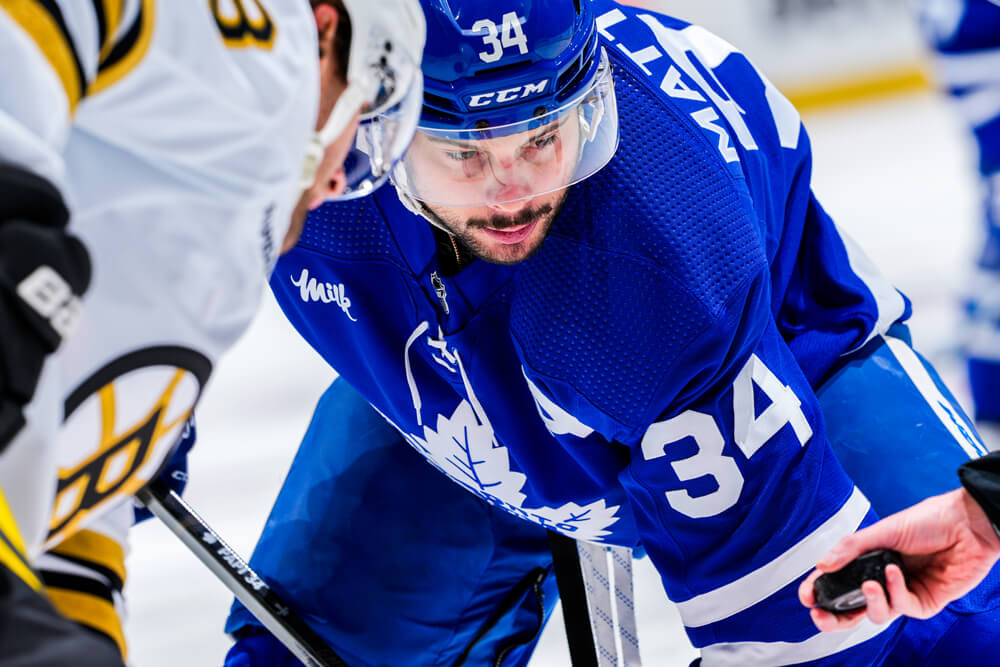

What a luxury it is for Colorado that Cale Makar chose to play defence. In truth, you could drop the smooth-skating rearguard into any spot on the ice and he would excel. Like the other elite, young blue-liners who’ve lit up the league over the past few seasons, it took only one night under the bright lights of the NHL for the hockey world to see that Makar was something special. He was quick and rangy and daring right from the start, scoring his first goal in his first game, in the post-season no less. In the half-decade since, he’s collected the second-most points in the league from the blue line, Roman Josi earning a pair more, albeit in far more games. On paper, it may be difficult to pull apart why exactly Makar stands out from the other new-school rovers in the league, the Hugheses and the Foxes. But you can see it when he’s gliding through the neutral zone with the puck on his stick, when he darts into the offensive zone and dances around the opposition, a whirling dervish of deception and offensive instincts. He simply seems to possess another gear, of dynamism, of strength, of savvy.
He also seems to have a knack for unleashing the full weight of that extra gear when it matters most. Perhaps it was because he began his NHL career in the post-season that Makar feels so at home in the grind of the playoffs. Whatever it is, it’s worked wonders for his club — in the five years since he debuted during the 2019 playoffs, Makar’s amassed 20 goals and 74 points in 62 post-season appearances, more than any other defender in the game. Rewind back to that moment of Stanley Cup glory in 2022, and it wasn’t one of the all-world Avs forwards getting the Conn Smythe nod — it was Makar, cleaning up after pacing all blue-liners in post-season scoring, and all playoff skaters not named McDavid or Draisaitl. The terrible news for the rest of the league is he seems to only be getting better. Just 25 years old, fresh off a career 21-goal, 90-point season, the question isn’t whether Makar can maintain his current level — it’s how much higher he’ll have raised it when all is said and done.

Nathan MacKinnon’s big-league career has progressed much the same way the man himself moves out on the ice — pushing on with fervor, picking up into a gallop, gaining steam, until you look up and he’s rolling toward you like a tidal wave, all power and unstoppable momentum. It took a moment for the Colorado Avalanche standout at the very beginning, MacKinnon wading through a few early years trying to find his footing in the league. Then it caught, and he pushed off, a 97-point breakout season at age 22 bringing him his first Hart nomination. He never looked back, reeling off four more campaigns at or above that 90-point pace — the last of those bringing a true cementing of his legacy and place in the game, as Colorado lifted the Stanley Cup with MacKinnon pacing the league in goals. In the two years since that championship, MacKinnon’s graduated to another level, still. After a first turn with the century scorers in 2022-23, the 29-year-old ascended to peak form last season, running roughshod over the rest of the league with a 51-goal, 140-point effort. The outburst clinched him the first Hart Trophy nod of his career — after three turns as a nominee — and his first Ted Lindsay Award, too.
It’s a fitting path for the Nova Scotian phenom, this bulldozing approach to achieving greatness, this dogged hunt for glory. Because this is how MacKinnon plays the game. When he comes over the boards, his club desperate for that last-second winner, that tying goal, there is no calm — there is only chaos, harnessed and directed at whoever stands in his way. We talk of ‘dominance’ often in this sport, but no one who will step onto NHL ice in 2024-25 embodies that term more fully than No. 29. While the only man ranked above him on this list blends all-world speed with grace and finesse, MacKinnon pairs it with flat-out power. Still in his prime, he seems to be picking up more momentum as the seasons wear on.
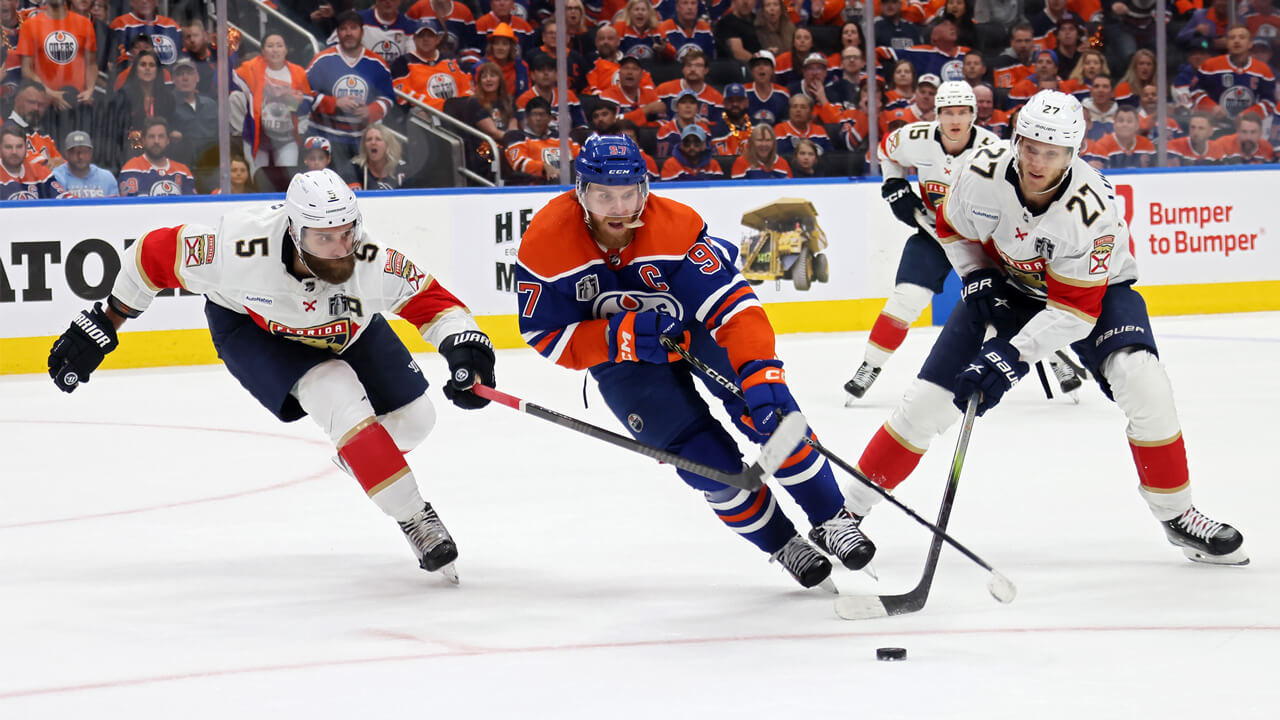

If you envisioned another name at No. 1, you might be overthinking this. The sheer weight of Connor McDavid’s presence every time he touches NHL ice should be proof enough of where he ranks among the game’s very best. If it isn’t, here’s something more concrete: Since No. 97 debuted in the big leagues in 2015, no player has amassed more points than his 982, the next-highest scorer sitting 141 below him. No player has collected more silverware, the Oilers captain claiming — in nine years — five scoring titles, three Hart trophies, four MVP nods from his fellow players, one Rocket Richard Trophy and one Conn Smythe. He’s been a point-per-game producer every season he’s been in the league, pushing that average closer to a ridiculous 1.80 points-per-game clip over the latter half of his career. He’s reached the 100-point plateau in seven of nine seasons, missing it once because he finished with 97 points in just 64 games, and once because his rookie season was cut short by injury after just 45 tilts. He has four 30-goal seasons to his name, three 40-goal seasons, and is one of only five players in the past 20 years to have potted 60 goals in one campaign. And then there’s the more recent run — 100 points in 50 games, the 123-point season, the 153-point season. Sixty goals, 100 assists. If the regular season’s a write-off, how about the post-season? McDavid’s amassed 95 playoff points over the past three years alone, far and away the league leader. Twice, his Oilers have mounted deep post-season runs, including the 2024 Cup Final march that finished just one win shy of a championship banner — both times, McDavid led the league in post-season scoring, both times producing at better than a 1.60 points-per-game clip.
But it isn’t really about the numbers, is it? They’re the quantifiable result of what makes McDavid great, but they aren’t the thing itself. Because what truly makes No. 97 the best in the world — at this moment, and for a while now — isn’t quantifiable. It isn’t found on the scoresheet, or in the record books, or in his trophy case. It’s in the moments he authors out on the sheet, the brilliance that reshapes what you believed was possible with the ingredients of ice, sticks, and skates. Watch No. 97 pick up steam in his own zone with the puck on his blade, watch him slice through the opposing team so quickly and with such grace you wonder how his hands and brain can keep up with his feet, and then name another who could do it better. At this moment, on the doorstep of 2024-25, Connor McDavid is the sport’s undeniable best. Rewind further than that, as far back as you want to go, and he’d still remain up there among the very best to ever do it.
The NHL’s Top 50 Players 2024-25:
1 Connor McDavid, C, EDM
2. Nathan MacKinnon, C, COL
3. Cale Makar, D, COL
4. Auston Matthews, C, TOR
5. Leon Draisaitl, C/LW, EDM
6. Nikita Kucherov, RW, TBL
7. David Pastrnak, RW, BOS
8. Quinn Hughes, D, VAN
9. Sidney Crosby, C, PIT
10. Mikko Rantanen, RW, COL
11. Aleksander Barkov, C, FLA
12. Brayden Point, C, TBL
13. Roman Josi, D, NSH
14. Jack Hughes, C/LW, NJD
15. Matthew Tkachuk, LW/RW, FLA
16. Kirill Kaprizov, LW, MIN
17. Artemi Panarin, LW, NYR
18. Adam Fox, D, NYR
19. Igor Shesterkin, G, NYR
20. Mitch Marner, RW, TOR
(Read Nos. 11-20)
21. Miro Heiskanen, D, DAL
22. Connor Hellebuyck, G, WPG
23. J.T. Miller, C/RW, VAN
24. Victor Hedman, D, TBL
25. Elias Pettersson, C/LW, VAN
26. Jack Eichel, C, VGK
27. William Nylander, RW, TOR
28. Sebastian Aho, C, CAR
29. Filip Forsberg, LW, NSH
30. Brady Tkachuk, C/LW, OTT
(Read Nos. 21-30)
31. Connor Bedard, C, CHI
32. Zach Hyman, LW/RW, EDM
33. Sam Reinhart, C/RW, FLA
34. Evan Bouchard, D, EDM
35. Jason Robertson, LW, DAL
36. Charlie McAvoy, D, BOS
37. Rasmus Dahlin, D, BUF
38. Nico Hischier, C, NJD
39. Andrei Vasilevskiy, G, TBL
40. Noah Dobson, D, NYI
(Read Nos. 31-40)
41. Brad Marchand, LW, BOS
42. Roope Hintz, C, DAL
43. Sergei Bobrovsky, G, FLA
44. Mathew Barzal, C/RW, NYI
45. Jeremy Swayman, G, BOS
46. Jaccob Slavin, D, CAR
47. Nick Suzuki, C, MTL
48. Jake Guentzel, LW, TBL
49. Juuse Saros, G, NSH
50. Tim Stutzle, C, OTT
(Read Nos. 41-50)
Getty Images (5); Gene J. Puskar/AP; Derek Cain/Getty Images; Jason Franson/CP; Mark Blinch/NHLI via Getty Images; Bruce Bennett/Getty Images.




